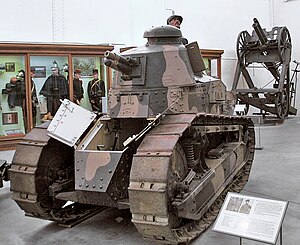| Renault FT | |
|---|---|
 FT with Girod turret at Royal Museum of the Armed Forces, Belgium | |
| Type | Light tank |
| Place of origin | France |
| Service history | |
| In service | 1917–1949 |
| Used by | See Operators |
| Wars |
|
| Production history | |
| Designer | Louis Renault and Rodolphe Ernst-Metzmaier |
| Designed | 1916 |
| Manufacturer | |
| Produced | 1917–1919 |
| No. built | +3,000, 2,622 by France |
| Variants |
|
| Specifications | |
| Mass | 6.5 tonnes (6.4 long tons; 7.2 short tons) |
| Length | 5.00 m (16 ft 5 in) |
| Width | 1.74 m (5 ft 9 in) |
| Height | 2.14 m (7 ft 0 in) |
| Crew | 2 (commander, driver) |
| Armor | 8 to 22 mm (0.31 to 0.87 in) |
Main armament | Puteaux SA 1918 37 mm gun or 8 mm Hotchkiss machine gun Reibel machine gun (FT 31) |
| Engine | Renault 4-cyl, 4.5 litre, thermo-siphon water-cooled; Gasoline (petrol) pump; Engine oil pump; Zenith preset carburettor; Magneto ignition 39 hp (29 kW) at 1500rpm |
| Power/weight | 5 hp/t (3.7 kW/t) |
| Transmission | sliding gear; four speeds forward, one reverse. One main clutch plus two subsidiary clutches (one for each of the two tracks) used for steering the tank. |
| Suspension | vertical springs |
| Fuel capacity | 95 litres (about 8 hours) |
Operational range | 60 km (37 mi) |
| Maximum speed | 7 km/h (4.3 mph) |
The Renault FT (frequently referred to in post-World War I literature as the FT-17, FT17, or similar) is a French light tank that was among the most revolutionary and influential tank designs in history. The FT was the first production tank to have its armament within a fully rotating turret.[note 1] The Renault FT's configuration (crew compartment at the front, engine compartment at the back, and main armament in a revolving turret) became and remains the standard tank layout. Consequently, some armoured warfare historians have called the Renault FT the world's first modern tank.[2]
Over 3,000 Renault FT tanks were manufactured by France, most of them in 1918. After World War I, FT tanks were exported in large numbers. Copies and derivative designs were manufactured in the United States (M1917 light tank), in Italy (Fiat 3000), and in the Soviet Union (T-18 tank). The Renault FT saw combat during the interwar conflicts around the world but was considered obsolete at the outbreak of World War II.
- ^ "TANQUES E BOMBARDEIROS EM SÃO PAULO: A REVOLTA TENENTISTA DE 1924". 5 July 2018.
- ^ Zaloga 1988, p. 3.
Cite error: There are <ref group=note> tags on this page, but the references will not show without a {{reflist|group=note}} template (see the help page).